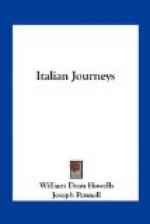This Gonzaga, being so much engaged in war, seems to have had little time for the adornment of his capital. The Church of Our Lady of Victory is the only edifice which he added to it; and this was merely in glorification of his own triumph over the French at Taro. Mantegna painted an altar-piece for it, representing the Marquis and his wife on their knees before the Virgin, in act of rendering her thanks for the victory. The French nation avenged itself for whatever wrong was done its pride in this picture by stealing it away from Mantua in Napoleon’s time; and it now hangs in the gallery of the Louvre.
Francesco died in 1519; and after him his son, Federico II., the first Duke of Mantua, reigned some twenty-one years, and died in 1540. The marquisate in his time was made a duchy by the Emperor Charles V., to whom the Gonzaga had given efficient aid in his wars against the French. This was in the year 1530; and three years later, when the Duke of Monferrato died, and the inheritance of his opulent little state was disputed by the Duke of Savoy, by the Marquis of Saluzzo, and by the Gonzaga, who had married the late Duke’s daughter, Charles’s influence secured it to the Mantuan. The dominions of the Gonzagas had now reached their utmost extent, and these dominions were not curtailed till the deposition of Fernando Carlo in 1708, when Monferrato was adjudged to the Duke of Savoy, and afterwards confirmed to him by treaty. It was separated from the capital of the Gonzagas by a wide extent of alien territory, but they held it with a strong hand, embellished the city, and founded there the strongest citadel in Italy.
Federico, after his wars for the Emperor, appears to have reposed in peace for the rest of his days, and to have devoted himself to the adornment of Mantua and the aggrandizing of his family. His court was the home of many artists; and Titian painted for him the Twelve Caesars, which the Germans stole when they sacked the city in 1630. But his great agent and best beloved genius was Giulio Pippi, called Romano, who was conducted to Mantua by pleasant Count Baldassare Castiglione.




